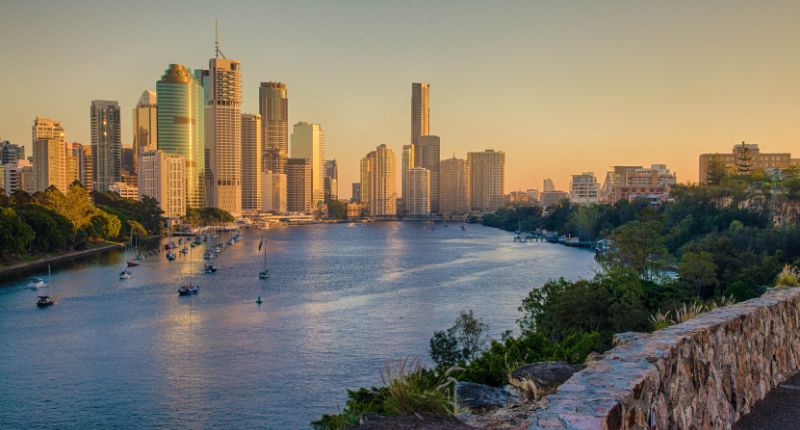
- Brisbane's capital growth rose 50.2% since the onset of the pandemic.
- Brisbane's median dwelling value now sits at $787,217.
- A few market headwinds might slow the pace of Brisbane's growth.
The median dwelling values in Brisbane’s property market have just surpassed Melbourne’s for the first time in 14 years, with the median dwelling value having reached $787,217, according to CoreLogic‘s head of research, Eliza Owen.
Melbourne’s median dwelling value currently stands at $780,457.
Brisbane’s property market saw a strong increase of 13.1% in dwelling values across 2023.
In contrast, Melbourne experienced relatively modest growth at 7.0%.
Owen said Brisbane’s growth had seen extraordinary capital growth over the past few years, which can be partly attributed to the city’s increased population growth; the appeal of remote work from Brisbane was one major driver of that uplift in people calling Brisbane home and resulting in diminishing supply and a seller’s market.
Median dwelling value December 2023

Among the capitals, Brisbane has the third highest median dwelling value, trailing Canberra ($843,171) and Sydney ($1,128,322)
Ripples from the pandemic
Since the beginning of the COVID pandemic in March 2020, Brisbane’s dwelling values soared 50.2% through to the end of 2023.
However, in that same period of time, Melbourne’s values only recorded an 11.0% rise, which was the smallest increase of any capital market city.
“The reason for such varied capital growth outcomes may be partly due to lifestyle factors, where the appeal of South East Queensland rose through the pandemic,” said Owen.
“The normalisation of remote work for many professionals made interstate migration to Queensland more feasible, while Melbourne’s extended lockdowns from March 2020 through to October 2021 may have prompted people to leave the city.”
Eliza Owen, CoreLogic
Indeed, in 2021, the Australian Bureau of Statistics (ABS), noted there were 276,661 interstate arrivals in Queensland, while Victoria recorded 179,659. Victoria also saw more departures at 189,150 compared to Queensland’s figure of 169,112.
The ABS also noted Queensland’s figures for interstate arrivals were an ‘unprecedented’ jump.
Owen told The Property Tribune that the surge of internal migration, much of it directed at South East Queensland, and the resulting extreme supply and demand mismatch, could not have been predicted by many planners or policy makers.
“In the 2021 to 2022 financial year, ABS reported Brisbane saw just over 59,000 people added to the population, which, assuming average household size of 2.5 people, equates to additional housing demand of roughly 23,600,” she said.
“Yet in that same year, the change in estimated dwelling stock across Brisbane reported by the ABS was just 17,418, suggesting a shortfall of around 6,182 properties (noting that doesn’t account for vacancy of of existing stock, but at least in the rental market that has also been extremely low).
Cohen Handler buyers agent, Anna Ellis, said “Personally, I had more owner occupiers use our buyer’s agent service in 2023 than ever before, compared to investor clients.

“This tells me that the 2023 growth was driven from a fundamental need for housing in Brisbane rather than speculative investing.”
Melbourne’s downswing to continue
Although COVID lockdowns have not been a factor for well over a year, Owen said she expects the premium on Brisbane relative to Melbourne to further widen.
“Melbourne home values are still in decline, with the home value index for the city dipping a further 0.3% in the past four weeks,” she said.
She added Melbourne still has a few months left in its downswing, citing data that indicates listings are higher than average and kept accumulating toward the end of 2023.
“Time on market was drifting a little higher, and vendor discounting was increasing.”
Brisbane’s top performing suburbs in 2023
Across Greater Brisbane’s suburbs, the top performer was Macgregor, a southern suburb, which recorded a stellar annual change of 28.6%.
Brisbane’s top performers in 2023
| Rank | Suburb | SA4 Name | Median Value | Quarterly change | Annual change |
| 1 | Macgregor | Brisbane – South | $1,176,240 | 9.6% | 28.6% |
| 2 | Wishart | Brisbane – South | $1,282,399 | 8.0% | 27.3% |
| 3 | Salisbury | Brisbane – South | $1,030,132 | 4.4% | 24.4% |
| 4 | Eight Mile Plains | Brisbane – South | $1,230,591 | 9.9% | 24.4% |
| 5 | Mackenzie | Brisbane – South | $1,451,987 | 7.7% | 24.2% |
| 6 | Cooper Plains | Brisbane – South | $916,915 | 3.3% | 23.8% |
| 7 | Holland Park | Brisbane – South | $1,212,494 | 6.1% | 23.6% |
| 8 | Robertson | Brisbane – South | $1,723,583 | 6.1% | 22.9% |
| 9 | Kuraby | Brisbane – South | $1,082,776 | 4.7% | 22.8% |
| 10 | Yeerongpilly | Brisbane – South | $768,491 | 3.7% | 22.1% |
Source: CoreLogic
Ellis noted the the three segments that performed particularly strong in 2023 were newly renovated or newly built inner city houses, inner city apartments and townhouses, and affordable family friendly suburbs further afield.
“Regions such as Redlands, Centenary and Springfield have had huge growth,” she said.
Brisbane’s tailwinds and headwinds
Owen said Brisbane’s new ranking may be put to the test in the next few months ahead.
“Brisbane remains a seller’s market, but the pace of monthly growth in values has eased slightly, from 1.5% in October 2023 to 1.0% in December,” she said.
“There are headwinds for the market, mainly extreme weather events, heat, humidity and flooding, which may deter buyers.”
On the other hand, Ellis said the Brisbane Metro will be a game changer.
“It is a high speed and high frequency transport service to the city that is expected to cut commute times down by 30% in the morning and 50% in the afternoons during peak hour,” she said.
“I believe that suburbs that benefit from the Brisbane Metro will see a further boost in property values.”




